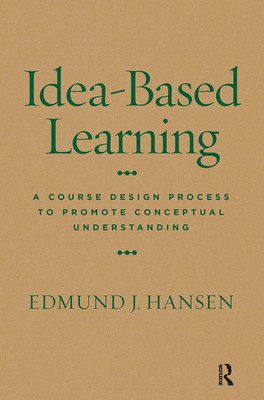
- We will send in 10–14 business days.
- Author: Edmund J Hansen
- Publisher: Stylus Publishing (VA)
- ISBN-10: 1579226132
- ISBN-13: 9781579226138
- Format: 15.5 x 23.1 x 2.3 cm, hardcover
- Language: English
- SAVE -10% with code: EXTRA
Reviews
Description
"Edmund Hansen shows faculty how college courses need to be designed! Hansen has the blueprint we all need to follow if we are to put together courses that will produce meaningful and long-lasting learning for our students."--Terry Doyle is the Chief Instructor for Faculty Development
Idea-based Learning takes as its point of departure the big conceptual ideas of a discipline that give structure and unity to a course and even to the curriculum, as opposed to a focus on content that can lead to teaching sequences of loosely- related topics; and aligns with notions of student- centered and outcomes-based learning environments.
Adopting a backwards design model, it begins with three parallel processes, first identifying the material that is crucial for conceptual understanding; second, articulating a clear rationale for how to choose learning outcomes based on student needs and intellectual readiness; and finally, aligning the learning outcomes with the instructional requirements of authentic performance tasks.
The resulting syllabi ensure cohesion between sections of the same course as well as between courses within a whole curriculum, assuring the progressive development of students' skills and knowledge.
EXTRA 10 % discount with code: EXTRA
The promotion ends in 17d.18:28:44
The discount code is valid when purchasing from 10 €. Discounts do not stack.
- Author: Edmund J Hansen
- Publisher: Stylus Publishing (VA)
- ISBN-10: 1579226132
- ISBN-13: 9781579226138
- Format: 15.5 x 23.1 x 2.3 cm, hardcover
- Language: English English
"Edmund Hansen shows faculty how college courses need to be designed! Hansen has the blueprint we all need to follow if we are to put together courses that will produce meaningful and long-lasting learning for our students."--Terry Doyle is the Chief Instructor for Faculty Development
Idea-based Learning takes as its point of departure the big conceptual ideas of a discipline that give structure and unity to a course and even to the curriculum, as opposed to a focus on content that can lead to teaching sequences of loosely- related topics; and aligns with notions of student- centered and outcomes-based learning environments.
Adopting a backwards design model, it begins with three parallel processes, first identifying the material that is crucial for conceptual understanding; second, articulating a clear rationale for how to choose learning outcomes based on student needs and intellectual readiness; and finally, aligning the learning outcomes with the instructional requirements of authentic performance tasks.
The resulting syllabi ensure cohesion between sections of the same course as well as between courses within a whole curriculum, assuring the progressive development of students' skills and knowledge.


Reviews